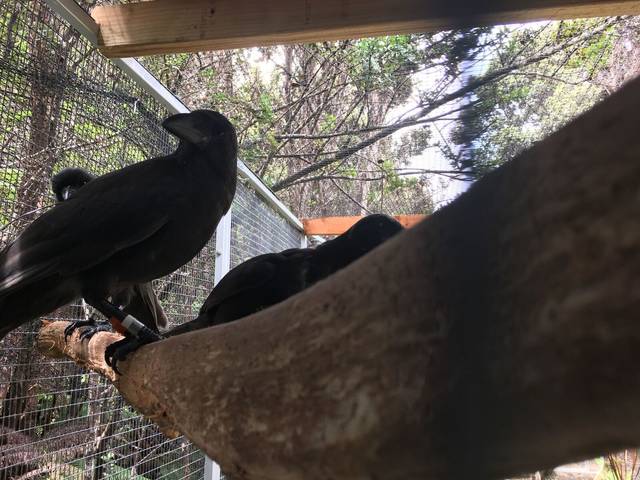Alala reintro efforts continue
Six young alala — critically endangered Hawaiian crows — were released into Puu Makaala Natural Area Reserve on the Island of Hawaii Tuesday.
The first group of birds: two females and four males took some time to emerge from the aviary where they had been temporarily housed and they appeared to show a natural curiosity for their surroundings. Plans are to release a second group of five birds: two females and three males in mid-October from the same release aviary.
Previously, in December 2016 a reintroduction attempt was halted after challenges posed by winter storms and predation on alala by io, the Hawaiian hawk. The concerted reintroduction efforts, funded by the State of Hawaii Department of Land and Natural Resources (DLNR), San Diego Zoo Global, and U.S. Fish and Wildlife Service have addressed those challenges by changing the timing of release to avoid winter storms, changing the release site location, releasing a social group of both males and females, and enhancing the “antipredator training program” to teach the released birds how to better respond to predators like io.
A high mortality rate is associated with releasing species into the wild. This is especially true for species like alala that have been in captivity for longer periods of time. A successful conservation breeding program gives managers the flexibility to adapt their management techniques to improve successful transition to the wild. Conservation breeding programs are key tools for recovering threatened and endangered species.
For example, the nene, or Hawaiian goose, has returned from the brink of extinction thanks to an intensive breeding program and the dedication of many partners over decades, and this species still requires active management and monitoring. For ‘Alala, these continued efforts are also essential to the species’ recovery.
“The recovery of the alala is an excellent example of partners working together to do something that has never been done before.” said Bryce Masuda, conservation program manager of the Hawaii Endangered Bird Conservation Program, in a press release. “Although bringing the alala back from the brink of extinction will take a lot of time and perseverance, many people are dedicated to saving this important species.”
Nine of the 2017 release birds were moved to a flight aviary in early 2017, to allow them to acclimate to the sights and sounds of the Hawaiian forest, and to socialize them with the two males that survived the December 2016 release. They were then transferred to a smaller aviary in the forest two weeks prior to the release. Puu Makaala Natural Area Reserve is an area that conservationists of the Three Mountain Alliance and DLNR have worked for decades to preserve, protecting native plants and species, and it represents a type of high-elevation habitat where alala originally lived before their numbers began to decline.


